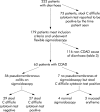Clostridium difficile associated diarrhoea in hospitalised patients: onset in the community and hospital and role of flexible sigmoidoscopy
- PMID: 15082585
- PMCID: PMC1774022
- DOI: 10.1136/gut.2003.028803
Clostridium difficile associated diarrhoea in hospitalised patients: onset in the community and hospital and role of flexible sigmoidoscopy
Abstract
Objectives: Clostridium difficile associated diarrhoea (CDAD) is a hospital acquired infection in which optimal methods for diagnosis and the scale of the problem in the community remain to be determined. In hospitalised patients with CDAD, we aimed to (i) study patients in whom the onset of diarrhoea was in the community and (ii) investigate the role of bedside flexible sigmoidoscopy in diagnosis.
Methods: Patients with CDAD (onset in hospital or community) were studied prospectively. In those with diarrhoea of unknown aetiology, flexible sigmoidoscopy was compared with stool assay for C difficile cytotoxin.
Results: Of 136 patients with CDAD (which was associated with antibiotic exposure in 96%), diarrhoea started in the community in 38 (28%; majority in own home) and while an inpatient in 98 (72%). The majority with CDAD onset in the community had been hospitalised over the preceding 12 months (86.8% v 57.1% in the hospital onset group; p<0.001). In 56 patients with pseudomembranous colitis at sigmoidoscopy, the stool C difficile cytotoxin test was negative in 29 (52%) but toxigenic C difficile was isolated from all of nine stool samples cultured. Of patients with pseudomembranous colitis, 30.4% relapsed over the subsequent 57.7(4.2) days.
Conclusions: In a significant proportion of hospitalised patients with CDAD, diarrhoea started in the community. However, the majority of these had been hospital inpatients previously when they may have acquired C difficile, with the subsequent onset of diarrhoea in the community following exposure to antibiotics. Flexible sigmoidoscopy is superior to the stool C difficile cytotoxin test in a subgroup of patients with pseudomembranous colitis. Sigmoidoscopy should therefore be considered in all hospitalised patients with diarrhoea in whom the stool test for C difficile cytotoxin and enteric pathogens is negative.
Figures
References
-
- Larson HE, Price AB, Honour P, et al. Clostridium difficile and the aetiology of pseudomembranous colitis. Lancet 1978;1:1063–6. - PubMed
-
- Bartlett JG, Tedesco FJ, Shull S, et al. Symptomatic relapse after oral vancomycin therapy of antibiotic-associated pseudomembranous colitis. Gastroenterology 1980;78:431–4. - PubMed
-
- Cleary RK. Clostridium difficile-associated diarrhea and colitis: Clinical manifestations, diagnosis, and treatment. Dis Colon Rectum 1998;41:1435–49. - PubMed
-
- Wilcox MH. Cleaning up Clostridium difficile infection. Lancet 1996;348:767–8. - PubMed
-
- Fekety R, McFarland LV, Surawicz CM, et al. Recurrent Clostridium difficile diarrhea: Characteristics of and risk factors for patients enrolled in a prospective, randomized, double-blinded trial. Clin Infect Dis 1997;24:324–33. - PubMed
Publication types
MeSH terms
Substances
LinkOut - more resources
Full Text Sources
Medical

